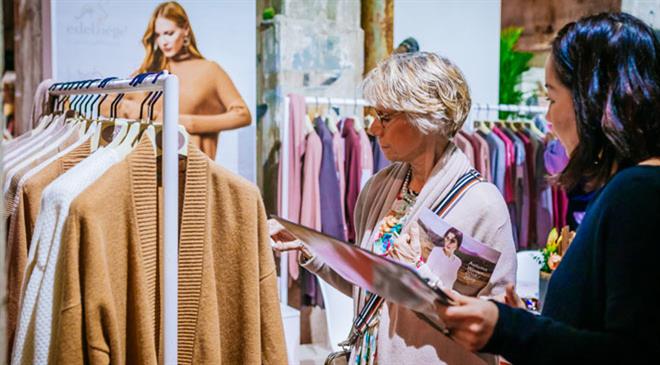Europe strong in sustainable fashion scene
Messe Frankfurt's Greenshowroom is an international trade fair exclusively for environment-friendly designs and has been held during the Berlin Fashion Week since 2009. The Greenshowroom presents high fashion and matching accessories while the Ethical Fashion Show Berlin highlights streetwear and casualwear. Both shows together form the largest platform for sustainable fashion in Europe. Olaf Schmidt, vice president, textiles & textile technologies, talks about the challenges in sustainable and ethical fashion and gives us a scoop of the latest in green fashion in Europe.
What do the apple and the arrow passing through it symbolise in the Greenshowroom logo?
The logo was already used by the Greenshowroom when we took it over. The arrow can certainly be interpreted as 'hitting the bull's eye' while the apple symbolises nature.

What is the current size of the global sustainable fashion industry? What is the expected growth rate by 2022?
I can mainly speak from the perspective of a trade show organiser. We started our activities in the field of sustainable fashion in Berlin with the acquisition of Greenshowroom in 2011. Half a year later, we launched the Ethical Fashion Show Berlin and extended the range of sustainably-produced fashion by progressively including street and casual wear. Having started as a niche topic, sustainable fashion is increasingly changing the shopping habits of our society. This change is reflected in the growth of our trade shows and, indeed, in terms of exhibitor and visitor numbers. Today, the Greenshowroom and the Ethical Fashion Show Berlin, held as part of the Berlin Fashion Week, form Europe's biggest B2B platform for ecological and fairly-produced fashion.
What is the agenda for these two shows in 2019? Will it be bigger?
We have had a very successful première at the Kraftwerk Berlin and a perfect start to our partnership with the Premium Group. We are now going into the preparations for our summer edition in July 2018. We will continue to promote the Kraftwerk as the most relevant meeting place for international buyers, influencers and media, looking for innovative brands with real stories. The offer will be enhanced by a number of inspiring side events such as curated runway shows, highly valued seminars, workshops and guided infotainment tours, plus a number of informal networking formats. Kraftwerk Berlin will be the place to find out about the future of fashion in summer 2018.
What were the highlights of the recently held Greenshowroom? What was the footfall and the number of participating brands?
With 170 exciting and highly committed labels, a wonderful audience of trade visitors and an unrivalled thematic spectrum, the last edition of the Greenshowroom and the Ethical Fashion Show Berlin exceeded all expectations. This year, for the first time, we held our shows at the erstwhile power station, 'Kraftwerk', in the centre of Berlin. With the successful premiere of our new FashionSustain conference and the collaboration with the Premium Group and their #Fashiontech conference & exhibitions, we have also found the perfect partner to transform 'Kraftwerk' into the foremost hub for tomorrow's fashion. Anyone who did not come to these shows has missed something.

Which were the standout brands and why?
In Berlin, we achieve a good mix of young and aspiring labels with fascinating design concepts and long-established labels. The Greenshowroom and the Ethical Fashion Show Berlin stand for sustainable, technical innovations and material developments representing resource-friendly alternatives that show the way to the future.
Which are the hotspots for sustainable fashion globally?
In terms of business and knowledge platforms, the Greenshowroom and the Ethical Fashion Show Berlin form Europe's biggest B2B platform for ecological and fairly-produced fashion making the Berlin Fashion Week unique compared to other international fashion events.
If you are asking about the number of sustainable fashion brands, the European countries are very strong. This is, at least, what we see from our exhibitors. However, in our last edition, we also had exhibitors from India, Korea, Thailand, the United States, Israel and Peru. Sustainability in fashion is becoming more and more global.
Which geographical areas are the brands and buyers from?
With 61 per cent of exhibitors coming from outside Germany, the Greenshowroom and the Ethical Fashion Show Berlin were more international than ever before. Most of the foreign exhibitors came from other European countries, in particular, the Netherlands, Spain, Portugal, Switzerland, the United Kingdom and Scandinavia. We are also noticing a growing interest from Indian exhibitors and already have several labels that have their origins in India or feature traditional Indian craftsmanship.
What are the challenges that sustainable and ethical fashion faces today?
Some of the big labels are already well established in the fashion market and their collections are increasingly to be seen in conventional trade. In the sustainable-fashion segment, there are also many small and young labels, which already have a substantial following. And this is the fascination of this part of the fashion world.
To be successful in the long term, sustainable fashion labels must, just like their conventional counterparts, reflect the zeitgeist of the fashion world. Innovativeness, especially when it comes to new materials or manufacturing processes, is also important. For example, natural materials, such as bio-cotton, are subject to environmental influences that can impact on the quantities available. Vegetable-tanned leather sometimes has flaws that make certain colour combinations difficult. Moreover, a variety of materials are unsuitable for specific collections. And sustainable labels must be able to cope with this. They must find solutions that ensure not only stable production but also a critical mass of customers in the long run.
Do you think the mainstream consumer is ready for fashion with a conscience?
Extremely interesting in this connection is the current Oekotex study, published last October. A worldwide poll of 11,000 consumers showed that 80 to 90 per cent are familiar with 'environment-friendly' clothing. Thirty six per cent of those who have purchased such garments have positive associations with them.
In fact, the buying behaviour of a large number of consumers is undergoing a process of change. More and more are buying bio foodstuff, travelling by climate-neutral means and shifting over to e-cars or car sharing. These consumers also pay attention to environment friendliness and fair payment when buying clothes. Accordingly, many fashion retailers and brands already offer their own sustainable collections or include sustainable labels in their assortments. In Germany, I would say that, just as every discounter has bio-foodstuff in their assortment, it will not be long before all conventional fashion retailers are also selling sustainable fashion brands.
Can you give us a percentage breakdown of menswear, womenswear and accessories displayed at the showroom and at the shows?
Women's outerwear still accounts for the better part of the spectrum to be seen at the shows. However, suppliers of men's fashions are catching up. Beside suppliers with collections for both sexes, we had some exciting labels with urban outdoor clothing and companies with high-grade, business-oriented fashions for men. The number of exhibitors offering accessories, such as shoes, bags, belts, caps and jewellery, has also grown from event to event.
What is your goal for 2025?
The fashion business is a fast-moving one. That also applies to the sustainable fashion sector. We, therefore, try not to look too far into the future. However, when it comes to fashion in general, we hope that sustainability will become the standard in the near future. (HO)
What went into curating the shows? How did you screen the participating brands?
In addition to our expectations on exhibitors regarding design, we also expect high standards in terms of environmental protection, social responsibility and transparency at the shows. Together with 'Get Changed! The Fair Fashion Network', we have developed a set of sustainability criteria. At least 70 per cent of the collections showcased must meet these criteria. Before we admit an exhibitor to one of the fairs, we check that it uses bio-materials, the production is socially responsible, recycled materials are used or they promote outstanding projects or traditional textile crafts. During the fairs, we conduct supplementary random checks.
Which were the top three sustainable innovations displayed in January 2018?
When it comes to innovation, I really like the labels in the shows. Trade visitors can see high-grade fashions made of recycled PET bottles, not to mention shoes made of bracket fungi, stone and maize, outdoorwear made of biodegradable fibres and bags made of pineapple leather. Manufacturing processes, such as T-shirt printing by sunlight, vegetable tanning processes for leather and closed-loop recycling concepts are only some of the environment-friendly methods to be seen. And, in terms of transparency, many labels already offer a complete overview of the materials and delivery chains of their collections through, for example, scannable labels.



